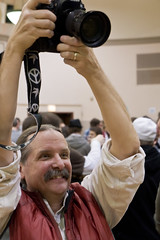Ultimately my concerns were minimized when I had a chance to actually have the NEX-5 in my hands and see just how small and pocketable it really is. Now, I had also been considering going with one of the competing micro-four-thirds (m4/3) cameras from Olympus or Panasonic, like the E-PL1 or GF-1, and only the Olympus has in-body stabilization. These cameras, too, have new lens mounts, though there are more lenses available since the first m4/3 camera debuted about fifteen months ago.
I finally decided to go with the NEX-5 for several reasons. First, Sony has released an adapter that permits it to use Alpha-mount dSLR lenses. With a firmware upgrade that came out in October, that adapter will autofocus most newer lenses. Also, the new firmware made significant improvements to the NEX-5’s user interface. Of particular importance to me is the addition of programmable buttons, to which you can assign your most used functions.
I was also convinced by the NEX-5 having full 1080 HD video rather than just 720. While 720 is certainly quite adequate for many applications, at this point I don’t see any reason not to go with 1080. Finally, one of the most appealing aspects of the m4/3 cameras is that there are adapters available to fit almost any camera lens out there, so you can use your Nikon, Canon or even Leica lenses. But then these sorts of adapters starting appearing for the NEX cameras, too.
I actually bought my NEX-5 at a brick-and-mortar store, Bel Air Camera in Westwood, Los Angeles, near the UCLA campus. They were offering it for the same price as everyone else (due to Sony’s pricing restrictions), and the salesman let me try it out with the new 18-200mm lens. He told me, “I don’t want to sell you that lens with that camera,” which was refreshingly honest. The reason why is because the lens is just way too big for the diminutive NEX-5, and I agreed. While it feels relatively well proportioned on a full-sized dSLR, on the NEX it really defeats the purpose of having such a compact camera.
On top of the NEX’s unique features as a compact interchangeable lens camera, I also was impressed by how much better its low-light, high-ISO performance is compared to my four-year-old a100. It’s really night and day, with the NEX rivaling the well-regarded low-light performance of the Nikon D300, which I use at work. Since I hate to use flash and like to take photos in light-challenged settings like rock clubs, I was really looking forward to getting the bump in low-light performance with the NEX.
I’ve had the camera now for just over two weeks and I’m just starting to get a feel for it. Lacking a viewfinder you compose your shot on the rear LCD, just like a point-and-shoot digicam. I don’t mind this aspect, though it does take some getting used to. The autofocus isn’t quite as fast as a dSLR, but it’s actually quieter and a little more certain than my a100, which was never known for its autofocus performance. When you want to manually focus you can magnify the center of the image on the LCD, which greatly helps nail it. In fact, I’m finding it easier to focus manually with the NEX-5 than with my dSLR. Neither is as easy to focus as my old manual film SLRs which have a split-prism viewfinder that lets you see precisely when you have focus, but those focusing screens aren’t included in any modern SLRs anymore.
At first I was actually kind of disappointed with the accuracy of the autofocus, finding my pictures not quite as sharp as I’d like. Part of this I attribute to the two lenses introduced with the camera, but then I found my few manually-focused pictures came out sharper. I realized the camera came set to multipoint autofocus which seems like it averages out the focus distance between a few different points in the scene. I prefer to just have one autofocus point in the center so I know exactly where the focus will fall. I’ve since changed the setting but haven’t had a chance to go out and really test the change.I can say that I’m very happy with the low-light performance. It truly blows away my old a100, giving me pretty clean images up to ISO 1600, and very useable images up to ISO 6400. At these higher ISOs there is noise, but it’s quite film-like and not at all unpleasing, especially given the fact that you can essentially take pictures lit by streetlight.
I did buy a Nikon lens adapter made by Fotodiox, located just north of Chicago in Waukegan, IL. With an adapter you have no autofocus, which is fine with me. You also have to set the aperture manually on the lens, but the camera still meters fine. The adapter I bought even lets you use newer G-series Nikon lenses that don’t have an aperture ring. In order to control aperture you use a little dial which opens and closes it. It doesn’t give you a precise reading, but you can see the results right on the LCD, which eliminates a lot of the guesswork. With daylight receding much earlier now I haven’t had much opportunity to take the NEX-5 out with some Nikon glass, but preliminary testing inside the house looks promising.
I’ve only shot a tiny bit of video that was worth anything, but still not with a tripod, which is really necessary if you’re going to get a steady image using such a tiny camera. The aforementioned firmware update now permits you to set the camera’s aperture manually, but only before starting to record. Frankly, that’s fine since you really shouldn’t need to change aperture while recording unless you’re doing long-form event or lecture recording. Even then, the NEX-5 really isn’t the proper tool for that job. Rather, the NEX-5 is well suited to cinema style single-camera shooting with short takes, just like all other video dSLRs.
Here’s a short 2 minute video I shot along Lake Michigan last week during an unseasonably warm spell last week. If you go to YouTube you can view it in full 1080 HD.
No, there is no microphone input on the NEX-5, but its m4/3 competitors don’t have inputs either, at least not without an adapter. While I have been strong advocate of mic inputs on camcorder I ultimately decided that it wouldn’t be a big deal for me. This is because I’m quite comfortable using a separate digital audio recorder to capture audio, just like you would when shooting film. Plus, the digital audio recorder arguably will capture higher quality sound, with more precise level controls. The NEX-5 and my Zoom H2 audio recorder together take up less space in a bag than my miniDV camcorder, so this is not the inconvenience it was several years ago.
I was pleasantly surprised to find that Final Cut Express and Pro imported my video footage without any hiccups. After importing it was immediately available in the timeline for editing. I’ve only imported about ten minutes of footage so far, so I don’t know what it will be like to work with an hour or more. But so far it’s been refreshingly easy.
I will definitely need more time to get more acquainted with the NEX-5 both as a still and video camera, but so far I’m quite happy. And I’m especially satisfied with its size and the ability to slip it into a coat pocket or a small bag where taking along a dSLR would be unwieldy. I’m also interested in using it in a two-camera setup with my Sanyo Xacti VPC-CG10 palm-sized camcorder. While the Xacti doesn’t have nearly the same image quality, in good light its 720p HD video is high quality. Furthermore, the Xacti is even smaller and much cheaper, so I’ll be willing to put it places where I wouldn’t want to risk my NEX-5.
Stay tuned to mediageek for more updates about my experience with the NEX-5.




[…] if I’m going to be more serious about my picture taking on an outing or trip I choose my Sony NEX-5, which is a bit bigger with a lens, but a much better performer until almost all conditions. But […]